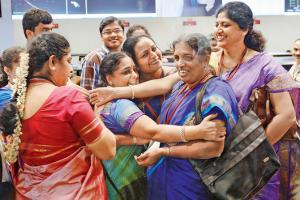A new book profiles ISRO's bright and leading female minds who make machines fly into space and prevent accidents on Earth

Staff from the Indian Space Research Organisation (ISRO) celebrate after the Mars Orbiter Spacecraft (MoM) successfully entered the Mars orbit. Pic/Getty Images
When you think scientist, the first word that would come to your mind would be "geek". If you'd let your imagination wander further, you'd picture a "nerdy recluse with Einstein-like frizzy hair".
ADVERTISEMENT
But the women scientists working at Indian Space Research Organisation (ISRO) "couldn't be more far away from this picture," says journalist and documentary filmmaker Minnie Vaid. Her new book, Those Magnificent Women and Their Flying Machines (Speaking Tiger), which narrates the inspiring stories of female scientists at ISRO, and how they negotiated gender barriers while leading "full lives with families and responsibilities" to achieve the impossible, is a shining case in point.

Minnie Vaid
Her book, over two years in the making, opens with stories of women who helmed the Mars Orbiter Mission (MOM), also called Mangalyaan - India's maiden interplanetary mission - that was launched in 2013. Around 500 scientists were roped in for the project, of which, 27 per cent key executive positions were held by women. It's also with Mangalyaan that for the first time, women scientists became more visible. The famed picture of cheery middle-aged, sari-clad women hugging each other, following the success of MOM, was the watershed moment for the country. That's also what got Vaid interested in their lives.
The opportunity, however, came only in 2016, when she was invited to a women's empowerment conclave, where the Mangalyaan women scientists were listed speakers. "Their stories about the Mars mission and how they went about handling work, family and children and a mission that was so time-bound and crucial were engrossing, more so because they were so matter of fact about it all," she recalls.
The journey began there on, with Vaid reaching out to ISRO to get permissions to gain access to all women scientists at the research organisation, be it the Mars mission or otherwise.
Among the many people she interviewed were Nandini Harinath and Ritu Karidhal from Bengaluru who were deputy operations directors and project managers design and operations respectively for MOM. In Ahmedabad, she reached out to Moumita Datta and Minal Sampath who worked on payloads or complex scientific instruments aboard the Orbiter.
"As I entered their world vicariously, I was initially awed and later envious of it; the meticulous preparation, the attention to detail including what could go wrong and how to avert it, the 'nerves of steel' which is a pre-requisite for any space scientist, as 'space is very unforgiving, you cannot afford to make a mistake'," she says of her experience of meeting them.
"The most striking feature common to all the women working on the MOM was the ability to remain calm and confident under extreme pressure," and how they juggled the personal and professional, of course. Nandini, in the book, recalls an incident when they had a review meeting on the Mars mission at 3.30 am. "We had been in office all day and all night in stressful conditions, and by 3 am, we were all really drained. But since the chairman had the energy to do a review, no one even thought of sleep. Later that morning, I had to attend a PTA meeting for Mahima [her daughter], who was then in class seven.
So, I had called her earlier and told her to request her teacher if I could come to school at 2 pm. Now Mahima does not talk much about what I do at ISRO. She merely said, 'My mother is doing something for the Mars mission and working late, so she will come later.' The astonished teacher immediately told her she was doing well and there was no need to disturb her mother!"
Vaid has also profiled 21 other women scientists as well. "I met a young scientist who had worked on the new railway crossing hooter (to prevent rail accidents), another research scholar who had gone to Antarctica on a project, a senior scientist who told me how she got around early biases about not sending a young female scientist to remote areas by sending two young women for the assignment," she remembers.
Despite all of this, female representation is the scientific community, continues to be abysmal. In its 2017-18 annual report, ISRO stated that women constituted approximately 18.8 percent of the total work force with an even lower 16 per cent in the scientists and technical category. "Of course the representation needs to be more; the scientists in the book provide explanations for why the numbers are low and the way forward. Statistically, the overall scenario of women scientists in India, and the world too in fact, is not very bright - women make up less than 30 per cent of those employed in scientific research and development across the world," says the author.
Catch up on all the latest Mumbai news, crime news, current affairs, and also a complete guide on Mumbai from food to things to do and events across the city here. Also download the new mid-day Android and iOS apps to get latest updates
 Subscribe today by clicking the link and stay updated with the latest news!" Click here!
Subscribe today by clicking the link and stay updated with the latest news!" Click here!






